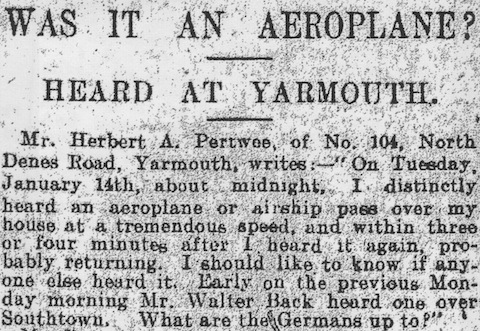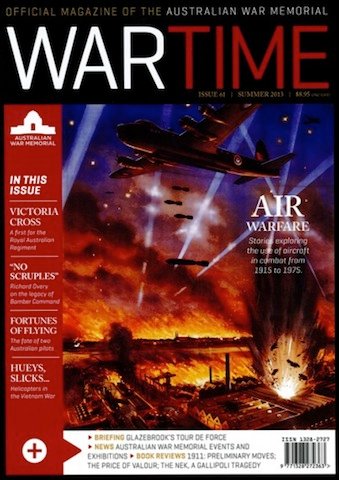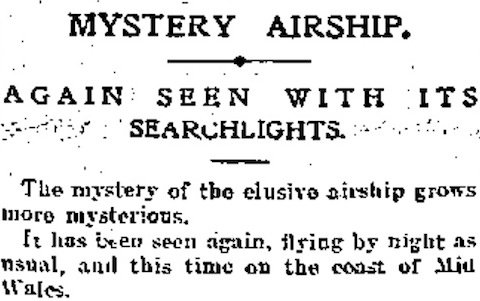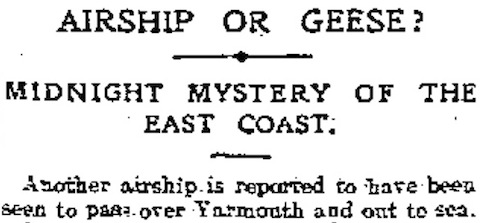
The Norfolk News, Eastern Counties Journal, and Norwich, Yarmouth, and Lynn Commercial Gazette, presumably universally known as the Norfolk News, today carries the usual paragraph about the Cardiff airship sighting. Unsurprisingly, it pays considerably more attention to the mystery aircraft heard locally at Yarmouth at midnight last week (above, p. 10). It reproduces Herbert Pertwee's letter to the rival Eastern Daily Press:
On Tuesday, January 14th, about midnight, I distinctly heard an aeroplane or airship pass over my house at a tremendous speed, and within three or four minutes after I heard it again, probably returning. I should like to know if anyone else heard it. Early on the previous Monday morning Mr. Walter Back heard one over Southtown. What are the Germans up to?
Note that the previous report had given the date as 15 January, not 14 January, but this discrepancy is easily explained by the time being midnight. Pertwee was interviewed by a representative of the press (what part of the press is not specified, so probably the Daily Press):
he noticed that the aeroplane had a very high-toned hum. There was no sound earthward at the time, all of it coming from above. The sound came towards him, passed away, and then returned, the airship apparently travelling at a very great speed. It was between midnight and 1 a.m. when he heard it over his house. His partner, Mr. Back, had mentioned to his son hearing a similar sound on the previous Monday morning [13 January 1913] before he met Mr. Pertwee. Mr. Back heard the sound between 2 and 3 a.m., and thought it might have come from a hydroplane. If it was anything of the sort Mr. Pertwee thinks it must have come from a considerable distance, otherwise if it had been in this district something must have been known of its movements.
The Norfolk News notes that after Pertwee's letter appeared in the Daily Press, 'several residents' have told its Yarmouth correspondent that 'they heard what they took to be an aeroplane pass over Yarmouth at about Tuesday midnight (14th instant)'. But it doesn't quote or name any of these other witnesses, instead reprinting another letter evidently from the Daily Press, written by 'Mr. F. W. Boulton, 20, Gordon Road, Southtown' relating to an incident a couple of months ago (so a few weeks after the Sheerness airship but maybe around the time it reached the press):
I was greatly interested on reading your report in this morning's issue of a supposed airship or aeroplane passing over Yarmouth, about the middle of November last [1912] I heard what I took to be an airship pass over Southtown. The time was about half an hour after midnight, and both my wife and myself distinctly heard a loud whirring, humming noise, which gradually diminished as though receding into the distance. As the time was about the middle of our herring fishing, it struck me on second thoughts that the noises might have come from a vessel in the harbour, although it appeared to be overhead, and became fainter and fainter as if getting further and further away. As I found nobody else seemed to have noticed the incident, after a bit I dismissed it from my mind, only to have it brought back afresh by reading Mr. Pertwee's communication in this morning's paper.
Both Pertwee and Boulton have used their local knowledge and contacts to assess what they heard. Pertwee seems to have inquired about local aircraft flights, or perhaps just assumed he would have heard of any. He and his business partner shared their experiences, and Pertwee took the initiative to write to a newspaper and ask if anyone else heard it as well. Clearly the sound, whatever it was, became the subject of gossip and rumour, with a number of people telling a reporter from another paper they had heard it too. Boulton also asked around, but finding that he and his wife were the only ones to notice anything decided not to worry about it. His thought that the sound might come from a herring trawler is reminiscent of the Dover Express's explanation for the Dover airship, though presumably it would be quite a familiar sound in a fishing port. None of the witnesses suggest that they have any familiarity with aircraft, but they seem reasonably confident in their ability to identify one by its sound -- well, it came from above, so what else could it be? Since Pertwee has inferred that the aircraft was not a local one, and given that it was flying in the middle of the night, to conclude that it was a German airship might be reasonable, though not a German aeroplane as he apparently has done. It's curious that none of the witnesses seem to have rushed outside to see if anything was visible, but perhaps the lateness of the hour explains that.






